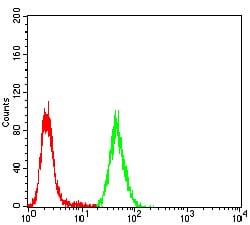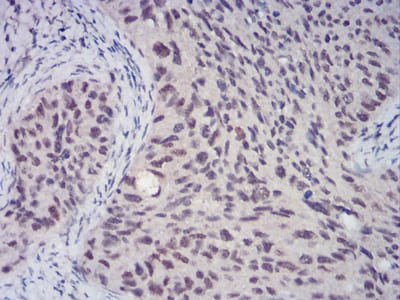



| WB | 咨询技术 | Human,Mouse,Rat |
| IF | 咨询技术 | Human,Mouse,Rat |
| IHC | 1/200 - 1/1000 | Human,Mouse,Rat |
| ICC | 技术咨询 | Human,Mouse,Rat |
| FCM | 1/200 - 1/400 | Human,Mouse,Rat |
| Elisa | 1/10000 | Human,Mouse,Rat |
| Aliases | PC2; NBP16 |
| Entrez GeneID | 8535 |
| clone | 6C5G3 |
| WB Predicted band size | 61.4kDa |
| Host/Isotype | Mouse IgG1 |
| Antibody Type | Primary antibody |
| Storage | Store at 4°C short term. Aliquot and store at -20°C long term. Avoid freeze/thaw cycles. |
| Species Reactivity | Human |
| Immunogen | Purified recombinant fragment of human CBX4 (AA: 397-514) expressed in E. Coli. |
| Formulation | Purified antibody in PBS with 0.05% sodium azide |
+ +
以下是关于CBX4抗体的3篇参考文献及其摘要概括:
1. **文献名称**: "CBX4 Mediates HIF-1α-Dependent Tumor Metastasis in Hepatocellular Carcinoma"
**作者**: Liu et al.
**摘要**: 该研究揭示了CBX4通过调控HIF-1α的稳定性促进肝癌转移的机制,并开发了特异性CBX4抗体用于检测其在肿瘤组织中的表达,证实其与患者预后不良相关。
2. **文献名称**: "Polycomb Protein CBX4 Sustains Embryonic Stem Cell Pluripotency through SUMO Modification"
**作者**: Zhang et al.
**摘要**: 本文利用CBX4抗体进行染色质免疫沉淀实验,发现CBX4通过SUMO化修饰维持胚胎干细胞多能性,并参与Polycomb复合体对关键基因的转录抑制。
3. **文献名称**: "CBX4 Coordinates the DNA Damage Response via Ubiquitin Signaling"
**作者**: Wang et al.
**摘要**: 研究通过CBX4抗体的蛋白质互作分析,揭示了CBX4在DNA损伤修复中的作用,其通过调控泛素化信号通路促进修复因子募集至损伤位点,影响基因组稳定性。
这些文献均涉及CBX4抗体的应用,涵盖癌症、干细胞及DNA修复等研究领域。
The CBX4 antibody is a crucial tool for studying the Chromobox homolog 4 (CBX4) protein, a member of the Polycomb group (PcG) family. CBX4. also known as hPc2. is a component of the Polycomb repressive complex 1 (PRC1), which plays a central role in epigenetic gene regulation by maintaining transcriptional repression of target genes, particularly through chromatin modification. CBX4 contains a conserved chromodomain that binds to trimethylated histone H3 lysine 27 (H3K27me3), a hallmark of PRC2-mediated silencing, linking PRC1 and PRC2 activities in establishing stable gene repression. Beyond its role in PRC1. CBX4 uniquely functions as a small ubiquitin-like modifier (SUMO) E3 ligase, regulating processes like DNA damage response, senescence, and stem cell pluripotency via SUMOylation of substrates such as HIPK2 or ΔNp63α.
CBX4 antibodies are widely used in research to investigate its expression, localization, and molecular interactions in developmental processes, cancer, and aging. They enable techniques like Western blotting, immunofluorescence, chromatin immunoprecipitation (ChIP), and immunohistochemistry to map CBX4’s tissue-specific distribution, nuclear dynamics, and association with chromatin. Studies using these antibodies have revealed CBX4’s dual roles in oncogenesis, where it acts as both a tumor suppressor (e.g., in squamous cell carcinoma) and a promoter of metastasis (e.g., in liver cancer), highlighting its context-dependent functions. Validated CBX4 antibodies are critical for exploring its therapeutic potential and mechanistic insights into epigenetic regulation, cellular differentiation, and disease progression.
×